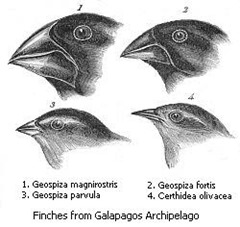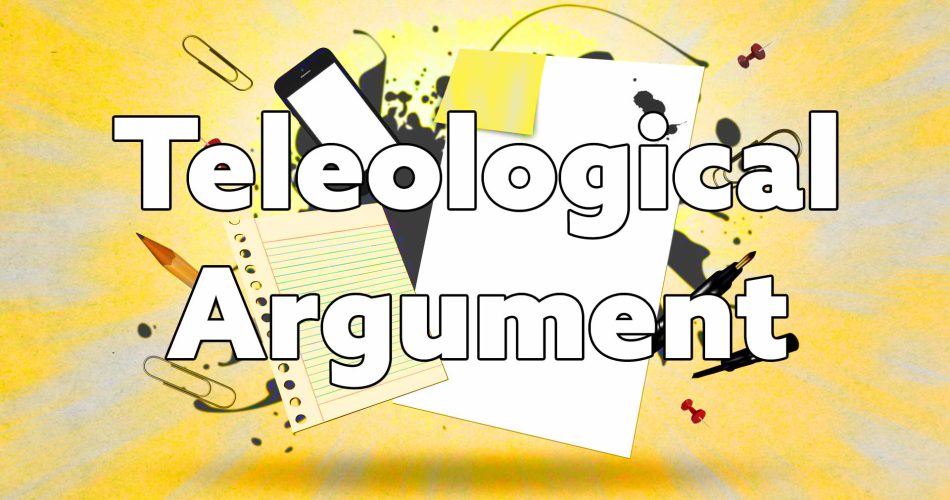In the previous post about arguments for the existence of God, we touched upon the Cosmological argument. We scratched the surface, presented the Argument in its simplest form, and examined some objections to it. In the end, we promised to go deeper in a future blog post. That is precisely what we’re going to do here with the teleological Argument.
The reason is that we want an overview of various arguments so we know the basic forms and types of objections. Then we’ll go deeper into each one later.
The Argument
The Teleological Argument is also known as the Argument from design. That basically means – a person making the Argument looks at the world, and notices that it resembles things that have been deliberately designed or that things seem orderly, so by analogy to other objects which are designed, they conclude that the world must have been intelligently designed.
Definition of teleological:
Merriam-Webster Dictionary
exhibiting or relating to design or purpose, especially in nature
So, it would be more correct to say that this is an Argument to design, not from design. The Argument examines nature and concludes that it has been created.
The name “argument from design” implies that nature has been designed but that theists and atheists simply disagree whether these natural designs require designers. But theists must argue TO design, they cannot assume it.
Paraphrased from “The Non-Existence of God” by Nicholas Everitt, 2003.
Side note: Everitt, in his brilliant book, separates the teleological argument into an argument from order and an Argument to design, but we will not go into this here, as it’s a big detour, and this is an introductory article. But if you have a more profound desire to learn more, I highly recommend buying that book.
Suffice it to say that you should not presume design. The design needs to be argued for. You can observe an orderly universe and see where that gets you but that is a separate issue from arguing for design.
So, for the introductory article, it’s enough to say that it’s an argument by analogy. The world resembles objects which have been designed by humans, so – to use the famous Paley’s watchmaker analogy – just as it would be reasonable when discovering a watch to conclude humans have created it, it would be in a similar way reasonable to look at the whole world, universe, nature, what have you and conclude a cosmic designer similarly designed it. Also, you might say it’s also an argument “from experience” since it starts from what we know about the world – complex things with a “purpose” are the result of design – and design requires a designer.
To put it VERY crudely, the designer saw that some feature, say a wolf’s keen sense of smell, would be helpful to, and for that “purpose” he designed those things in that way. It’s all part of a grand design. The wolf, or even the whole of nature, is an excellent machine with parts designed for a purpose, like every part of a watch. As the watch displays signs of design, so does nature and the designer of nature is like the mind of a human. The argument would have us say that just as it’s reasonable to come upon a watch and conclude it was designed, it’s sensible to look at the entire nature and conclude it was designed.
Presented like this, the argument does have its appeal. But is it any good if we think about it a bit deeper? Let’s see why it’s not enough to convince us of the existence of God.
Again, as always, please note that this is an introductory article. There are many versions of the teleological argument which will escape some of the criticisms we used here. We’ll discuss them in a different post, so stay tuned.
Some criticisms and objections
Problems with analogies and experiences

One thing worth noting about analogies is that they work very well only when the objects or events are very similar. Suppose we observe that some plants reproduce by attracting pollinating insects. In that case, we might conclude that the plants which have similar features reproduce in the same way, but we cannot go even so far as to argue that ALL plants reproduce by attracting pollinating insects.
That would be going too far – and indeed, some plants are reproducing asexually. So even if we limit our experience with pollination to the plant world, we need to be careful about where our observations take us, let alone if we try to take our expertise outside of the plant world.
And that is what arguments from (or to) design do. They argue from paintings, watches and toy cars to the universe. That is essentially what is claimed as a problem with some versions of the teleological argument.
As Hume in his “Dialogues Concerning Natural Religion” argued, we have no experience whatsoever with universes coming into existence. Our experience with everyday objects is nothing like that. The universe seems unique – we have no experience with designers creating similar universes, so we have no basis for saying that our universe was designed, since our experience is with things radically different from the universe.
Next, as Hume argues, the analogy to the watches or machines is not even a perfect one since the universe has more similarity to a vegetable than the watch:
“The world plainly resembles more an animal or a vegetable, than it does a watch or a knitting-loom. Its cause, therefore, it is more probable, resembles the cause of the former. The cause of the former is generation or vegetation.
The cause, therefore, of the world, we may infer to be something similar or analogous to generation or vegetation.”
Dialogues Concerning Natural Religion by David Hume
Our experience is not an appropriate guide when trying to argue to the design of the universe. First, we have no experience with things like the universe coming into existence, and second, the universe seems closer to natural things like vegetables than to objects designed by humans.
But Hume is not even done yet with this group of points. He goes on to argue that we see everyday minds arise from physical things – the brains, but we never see vegetables rising from intelligence. In short, minds are dependent on brains, which are physical things. You never see a self-sustaining mind which gives rise to other things. So, if a designer is supposed to resemble the mind of a human, it should similarly to humans depend upon something else, as our minds depend on the brains, which rely on physical things. All our experience with any design tells us that designers are physical entities.
Problems with design?
Next, there are some additional problems when arguing about a design. Let’s say we ignore the previous group of arguments. What kind of design could the universe be, and what type of designer could have made it?
First, what is worth noting is that, like a cosmological argument, it does not follow that there must be precisely one designer. Nothing in the argument shows that there is exactly one designer at work. When that is taken into consideration, other design ideas open up.
Most of these ideas are perfectly described by Hume. I cannot overstate how vital his criticisms are. So, from experience, we know that some designs are the product of a single designer, yes, but more complex designs are often the product of groups of designers and architects. Take buildings, rockets, or ships – in none of those examples will you find a single designer producing everything by themselves. Those things are products of many minds working together. If we apply this reasoning to our world, it is much more likely that the arguments support polytheism than monotheism.
Next, Hume tells us that it is not at all evident that this world is successfully designed. Given the imperfections in the world, it seems more likely that the world is a failure. It could have been the first attempt at design by a lesser or an infant designer.
“This world, for aught he knows, is very faulty and imperfect, compared to a superior standard; and was only the first rude essay of some infant deity, who afterwards abandoned it, ashamed of his lame performance: it is the work only of some dependent, inferior deity; and is the object of derision to his superiors“
Dialogues Concerning Natural Religion by David Hume
Of course, once you get into the design, it is very possible that the world was even poorer in design than it is now, with some inept God tinkering with it until he got it right — or at least made it less crappy. We certainly have similar experiences with such designs in our world. Someone starts something, messes up, and then desperately tries to fix it until you have a complete mess that somehow keeps together.
So what Hume is saying is that any Argument for SUPERIOR design is problematic. Continuing down this path, we would now mention the argument from evil against the existence of God and how powerful it becomes against those who argue design because it really shows God as a less-than-successful designer. So, even if you consider the argument from evil to be well answered, the argument is more dangerous against those who argue to design. But we will handle this in another article.
Another point worth mentioning, found in Michael Martin’s Atheism – A Philosophical Justification, is that some versions of the Argument to design at most show an architect, but not a creator. It doesn’t really support the idea of God creating the universe from nothing because all our experience shows objects created from existing materials – the divine design without using existing materials is not derived from experience.
– Paraphrased from Martin, 1990.
Problems with the mind?
As with the cosmological argument, we also encounter a mind as an explanation here. As philosopher Simon Blackburn argued, it is not necessarily true that the cause of something must be complex. But it does seem that a cause must be more complicated than the object being designed. The argument tries to show that nature’s design is like that of watches or toy cars. In all these instances, the designer is indeed more complex – the designing force is thought to be like our reason.
But our reason comes late. Our reason depends on the brain, and the brain is fragile. Damaging the brain will indeed damage our capacity to reason. As we saw Hume argue earlier, the reason is also unusual. There are far more instances of not having a reason than there are of creatures having a reason – and in these cases, the reason is dependent upon the physical. We are asked to believe in a self-sustaining mind which doesn’t depend on anything and does not operate upon any pre-existing matter, all of which we have no experience.
Darwinism

Pictured: Four of the 13 finch species found on the Galápagos Archipelago, have evolved by adaptive radiation that diversified their beak shapes to adapt them to different food sources. (Wikipedia)
Darwinism is often treated as the only relevant point in discussions of these arguments, which inevitably leads theists to try to show either that evolution is compatible with theism or that evolution is false.
Therefore, we left the evolution point as the last one. Earlier points deal with most of the cosmology as well, so by starting with them we can say that we answered both a straightforward cosmological version of the argument to design and a straightforward Argument to create, which begins from biology so we can use Darwinism only to give ourselves extra force in countering arguments to design and not have our entire rejection depend only on evolution.
So if the argument to design is presented in a way that looks at how plants and animals seem like they were intended and uses that point to try and argue that they were in fact designed and that design requires a designer etc., we can and should remember that there exists an alternative explanation with much stronger support in reality – the theory of evolution which does an excellent job of explaining the seeming design of plants and animals and shows how through millions of years of adaptation and natural selection we can indeed completely naturally get an explanation for everything in nature.
What is worth noting is that evolution does not explain the start of life itself. Evolution needs something to get going. But once we have that first life or a first self-replicating molecule, we can explain everything else. Since evolution is not concerned with how life first began, it is not an argument against evolution that scientists do not precisely know how life first began. They are working on it, though, and there are some outstanding theories, but not a definitive answer yet.
But theists should not be so bold as to place a bet about the existence of God on such an argument – that we don’t know the origin of life. Once, we did not know about evolution at all. That all changed. Even if theists were to place god there, he would still have to defend himself from all the points raised above.
In short, evolution provides a fantastic explanation of what appears to be design in plants and animals, and some even think it lays to rest any argument for design that uses plants and animals as a starting point.
Conclusions
This was an introductory post about the teleological argument and why on the face of it we cannot accept it as proof of the existence of God because there are serious objections to it:
- Analogies don’t usually work well except for very similar things and events.
- We have absolutely no experience with Universes starting or being designed, so it doesn’t seem wise to use analogies there.
- The world does not even resemble watches, toy cars and other designed objects as much as it resembles vegetables and animals.
- We have no experience with minds without causes which design other things.
- The argument does not point to what most people call God because it supports either multiple designers or the first attempt by an incompetent designer. There is also no support to indicate creation as all designs we know of depend on the previously existing matter.
- There are problems with arguing the mind is the answer. Minds come late and depend on other things.
- When it comes to plants and animals, Darwinism provides a much better alternative explanation with real, physical evidence on its side.
Ending remarks
We have scratched the surface of teleological arguments and shown their most common usage and objections. There are more powerful versions of it that escape some of the arguments used here, and we will discuss those and objections to them in a future post. Stop by this website from time to time. We’re just getting started.
Further Reading
- For a quick overview and some problems visit RationalWiki
- Wikipedia is also a good, not too complicated resource.
- Teleological Arguments for God’s Existence, Stanford Encyclopedia of Philosophy
- Dialogues Concerning Natural Religion by David Hume
- Think: A Compelling Introduction to Philosophy by Simon Blackburn
- The Non-Existence of God by Nicholas Everitt
- Arguing about Gods by Graham Oppy
- Atheism: A Philosophical Justification by Michael Martin

